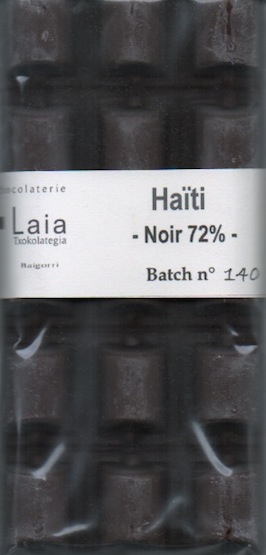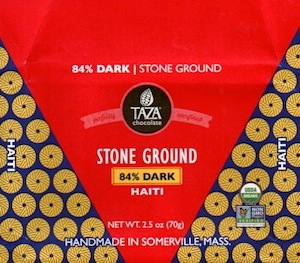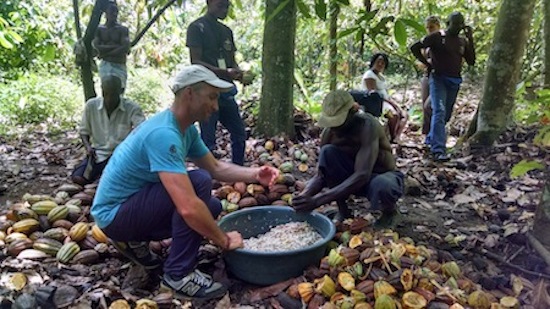Haiti
by VARIOUS:Laia
Shunsuke Saegusa
+3 more...

Impact
FAST FLASHBACK: a newcomer arrives on the scene called Vanilla Beans / Chocolate Design Company (see Flavor section below) to augment this feature on Haitian-sourced chocolate, originally posted a month ago
********************************
O, Haiti, how so many love to hate thee. Truthfully, you give them cause. The least of which may be your cocoa but, after these bars, a diminishing few include that on the list too. Just getting around the joint counts as another as well.
Not many Haitians own cars: less than 5 out of 1,000. Nothing bad in & of itself since autos contribute to all sorts of ecological ills. The situation of getting around the island is compounded by the fact that no railroad exists either. Lyfte® where art thou? Well, in the cities, people often take pre-Uber communal taxis & colorful public buses called "taptaps."
These 5 distinct barsmiths from 3 different continents all demonstrate that Haiti, & a widening part of the world, are tapping into the country's cacáo groves driven by increased demand for wild & exotic chocolate. While the results here are neither, they point to a country headed in the right direction.
Clustering a handful of bars crafted by various barsmiths, each utilizing cacáo from a single-origin, represents a, ahem, departure of sorts for the C-spot® in terms of a review format.
Change: a constant everyone, even the dead, can count on.
Not many Haitians own cars: less than 5 out of 1,000. Nothing bad in & of itself since autos contribute to all sorts of ecological ills. The situation of getting around the island is compounded by the fact that no railroad exists either. Lyfte® where art thou? Well, in the cities, people often take pre-Uber communal taxis & colorful public buses called "taptaps."
These 5 distinct barsmiths from 3 different continents all demonstrate that Haiti, & a widening part of the world, are tapping into the country's cacáo groves driven by increased demand for wild & exotic chocolate. While the results here are neither, they point to a country headed in the right direction.
Clustering a handful of bars crafted by various barsmiths, each utilizing cacáo from a single-origin, represents a, ahem, departure of sorts for the C-spot® in terms of a review format.
Change: a constant everyone, even the dead, can count on.
Appearance 4.2 / 5
| Color: | well, let's see… somewhere in the numbers field of the Pantone coloring book for zombies |
| Surface: | all good |
| Temper: | semi-glosses |
| Snap: | tough gong |
Aroma 7 / 10
falls into 2 broad classes:,
a) smoked coconut over the dying embers of a tire bonfire (Hévin and Saegusa -- see Flavor section below) -- modified somewhat by A. Morin's chocolate inkwell + a newfangled tag: tar-anise
or b)
-- uniquely decent for a Haitian (Laia also below) -- golden raisins commingled with malted grape nuts -> shifts to rye berries, caraway, fennel -> turns bluestone
a) smoked coconut over the dying embers of a tire bonfire (Hévin and Saegusa -- see Flavor section below) -- modified somewhat by A. Morin's chocolate inkwell + a newfangled tag: tar-anise
or b)
-- uniquely decent for a Haitian (Laia also below) -- golden raisins commingled with malted grape nuts -> shifts to rye berries, caraway, fennel -> turns bluestone
Mouthfeel 12.9 / 15
| Texture: | easy to just 'feel it' |
| Melt: | generally good lengths & roundness, even burly in some instances |
Flavor 41.1 / 50
Jean-Paul Hévin
Chocolat Noir; 75% cacáo-content; Lot #304
powers in toasted cocoa -> flash spice (cinnamon / allspice) -> coconuts tumbling forth with other nuts (almonds) hanging off a vanilla-figurine backed in white florescence (gardenia + woodruff) -> some of that rubber in the Aroma wafts over as latex -> rolls away caramellowly
Probable Pralus co-packer. Recalls Richart's early iteration of Haiti… from pre-Hurricane days (2010) before anyone would touch the stuff.
Plain, deceptively simple, solid bar with some floral tease.
INGREDIENTS: cocoa mass, sugar, cocoa butter, lecithin
Shunsuke Saegusa
Haiti; 66% cacáo-content
petrol chemicals, burning tar 'n rubber obscure underlying floral patterns which somehow manage to breakthrough nonetheless & conspire for sweet caramel with a marshmallow cloud -> wild cherry licorice... devolves into cough drops before reverting to cocoa syrup
More bar shock from the label that released a shocking Vietnam. Shunsuke Saegusa favors higher sugar counts & this prone cocoa really benefits from it. A chocolate that overcomes serious deficiencies early on, finds its better nature, & sticks it.
Single-origins can be intimidating to some, adding a complication to what most think of as mere candy. Flavor-wise, here's one for the masses.
Vanilla Beans / Chocolate Design Company
Hait 68%
A 2nd Japanese maker working with Haitian cacáo. Alone amongst all the barsmiths here, this one utilizes agave along with cane sugar which imparts a cooling metallic streak to an otherwise candied / caramelized brown syrup demeanor. Additionally, the company fattens up the lipids beyond cocoa butter with differing plant oils. All in a sign of just how impoverished these seeds must've been because very little base cocoa impressions survive except for a dirty bog of an ending.
INGREDIENTS: cocoa mass, cocoa butter, agave powder, sugar, plant fats & oils, lecithin
Laia
Haïti Noir 72%; Batch nº 140
more flowers, these crushed underfoot by heavy cocoa -> super sweet potato -> a short narrow strip of tar -> small absinthe splash in chocolate -> the now-patented Haitian spice pack instantiates fig & tamarind -> dragon fruit amidst a walnut-brownie
No déjà voodoo here. The cleanest / clearest of the bunch so far, missing the miasma of the others above.
A Francophile former colony, obviously a French connection exists between the island & Baigorri, France where Laia toils.
Marvelous, all things considered. Yet another barsmith sneaking up on the lead-pack.
INGREDIENTS: cocoa mass, sugar, cocoa butter, lecithin
A. Morin
Haïti Noir 70%; Lot nº 120115
crazed cocoa with blackened chocolate underside -> figs around the breadfruit tree -> sweet tar-anise wafts over from the Aroma -> charred nut skins -> black seed
Really up-roasted.
Morin, always quite intentional, probably concluded that these seeds required some high torrefaction to either braze off the deficiencies noted in a couple bars above &/or scorch this into a delimited profile free of subtlety. And certainly none here. To their credit, they take the heat well.
A straightforward Dark that inclines about 5% darker than listed.
INGREDIENTS: cocoa mass, sugar, cocoa butter, lecithin
Taza
The ever-conscientious friends-of-cacáo at Taza sent the whole barrel from 'bean-to-bar'… that is, seed-to-chocolate.
In the process, they upped their game in just about every aspect: the DirecTrade sourcing, the hi-quality paper stock wrapper in saturated colors -- damn, that alone makes this worth about half the cost -- not to mention the chocolate itself.

Produits Des Iles SA (PISA)
Pulled from a small growers network organized into an association called APROCANO (Association of Cocoa Producers from the North).The network counts 30 local groups so far representing some 1,500 members, each tending to certified organic cocoa on plots that average less than an hectare. These properties practice poly-crop 'Creole Gardening' along the island's north coast around Cap-Haitien. Another local organization -- PISA -- handles post-harvesting at a central facility, treating the produce to ~6 days fermentation in pine boxes, then solar-drying tunnels on raised wooden beds sheathed in plastic mesh.
As per the particulars of this motley sample awaiting genetics… well, medium-small size; a limited random check reveals fairly high fermentation rate
dry pungent vinaigrette on the inhale
flavor largely of sound cocoa quotient -> light banana, some agreeable Earth elements & scant bitterness (only at the very back & then significantly negated by vegetative action) -> thin astringency disguised as rum outlines the finish
All-in-all, a very clean if narrow & curtailed range accompanies some round bodied texture.
84% Dark - Haiti
Batch 1578
trippy mix of plum brandy / cocoa / bagasse -> fig -> dark morello cherry -> lite lime -> mango skin -> rear nut (blanched almond)
The most unique offering among the line-up: a) the hallmark coarse grind / texture of Taza (none of the whizbang refinery); b) the highest percentage cacáo-content of the group &, despite these 2 factors, c) the greatest fruit-laden upper-barrel nature of flavor. Uncanny. Doubly so considering that the Seeds of Pisa themselves (above) hardly evince such hints which follow-on in this bar. Make that triple taking into account the scent which conjures up a soiled-cocoa mud cake with a crust of funk / ink.
Taken altogether, a cacáo / cocoa of tough naturalism reformed into loose chocolate by a certain structural elegance.
Taza is getting to know this seed type intimately; in fact, the liner notes are uncharacteristically accurate for a niche that often spits out clueless taste-tags or, worse, misleading propaganda.
Arguably the label's most substantial bar all the way around to date: from its sourcing relationship at the origination point to the end flavor.
INGREDIENTS: cocoa mass, sugar
TAZA 84% DARK-HAITI WILL BE AVAILABLE COMMERCIALLY STARTING IN EARLY 2016
Chocolat Noir; 75% cacáo-content; Lot #304
powers in toasted cocoa -> flash spice (cinnamon / allspice) -> coconuts tumbling forth with other nuts (almonds) hanging off a vanilla-figurine backed in white florescence (gardenia + woodruff) -> some of that rubber in the Aroma wafts over as latex -> rolls away caramellowly
Probable Pralus co-packer. Recalls Richart's early iteration of Haiti… from pre-Hurricane days (2010) before anyone would touch the stuff.
Plain, deceptively simple, solid bar with some floral tease.
INGREDIENTS: cocoa mass, sugar, cocoa butter, lecithin
Shunsuke Saegusa
Haiti; 66% cacáo-content
petrol chemicals, burning tar 'n rubber obscure underlying floral patterns which somehow manage to breakthrough nonetheless & conspire for sweet caramel with a marshmallow cloud -> wild cherry licorice... devolves into cough drops before reverting to cocoa syrup
More bar shock from the label that released a shocking Vietnam. Shunsuke Saegusa favors higher sugar counts & this prone cocoa really benefits from it. A chocolate that overcomes serious deficiencies early on, finds its better nature, & sticks it.
Single-origins can be intimidating to some, adding a complication to what most think of as mere candy. Flavor-wise, here's one for the masses.
Vanilla Beans / Chocolate Design Company
Hait 68%
A 2nd Japanese maker working with Haitian cacáo. Alone amongst all the barsmiths here, this one utilizes agave along with cane sugar which imparts a cooling metallic streak to an otherwise candied / caramelized brown syrup demeanor. Additionally, the company fattens up the lipids beyond cocoa butter with differing plant oils. All in a sign of just how impoverished these seeds must've been because very little base cocoa impressions survive except for a dirty bog of an ending.
INGREDIENTS: cocoa mass, cocoa butter, agave powder, sugar, plant fats & oils, lecithin
Laia
Haïti Noir 72%; Batch nº 140
more flowers, these crushed underfoot by heavy cocoa -> super sweet potato -> a short narrow strip of tar -> small absinthe splash in chocolate -> the now-patented Haitian spice pack instantiates fig & tamarind -> dragon fruit amidst a walnut-brownie
No déjà voodoo here. The cleanest / clearest of the bunch so far, missing the miasma of the others above.
A Francophile former colony, obviously a French connection exists between the island & Baigorri, France where Laia toils.
Marvelous, all things considered. Yet another barsmith sneaking up on the lead-pack.
INGREDIENTS: cocoa mass, sugar, cocoa butter, lecithin
A. Morin
Haïti Noir 70%; Lot nº 120115
crazed cocoa with blackened chocolate underside -> figs around the breadfruit tree -> sweet tar-anise wafts over from the Aroma -> charred nut skins -> black seed
Really up-roasted.
Morin, always quite intentional, probably concluded that these seeds required some high torrefaction to either braze off the deficiencies noted in a couple bars above &/or scorch this into a delimited profile free of subtlety. And certainly none here. To their credit, they take the heat well.
A straightforward Dark that inclines about 5% darker than listed.
INGREDIENTS: cocoa mass, sugar, cocoa butter, lecithin
Taza
The ever-conscientious friends-of-cacáo at Taza sent the whole barrel from 'bean-to-bar'… that is, seed-to-chocolate.
In the process, they upped their game in just about every aspect: the DirecTrade sourcing, the hi-quality paper stock wrapper in saturated colors -- damn, that alone makes this worth about half the cost -- not to mention the chocolate itself.

Produits Des Iles SA (PISA)
Pulled from a small growers network organized into an association called APROCANO (Association of Cocoa Producers from the North).The network counts 30 local groups so far representing some 1,500 members, each tending to certified organic cocoa on plots that average less than an hectare. These properties practice poly-crop 'Creole Gardening' along the island's north coast around Cap-Haitien. Another local organization -- PISA -- handles post-harvesting at a central facility, treating the produce to ~6 days fermentation in pine boxes, then solar-drying tunnels on raised wooden beds sheathed in plastic mesh.
As per the particulars of this motley sample awaiting genetics… well, medium-small size; a limited random check reveals fairly high fermentation rate
dry pungent vinaigrette on the inhale
flavor largely of sound cocoa quotient -> light banana, some agreeable Earth elements & scant bitterness (only at the very back & then significantly negated by vegetative action) -> thin astringency disguised as rum outlines the finish
All-in-all, a very clean if narrow & curtailed range accompanies some round bodied texture.
84% Dark - Haiti
Batch 1578
trippy mix of plum brandy / cocoa / bagasse -> fig -> dark morello cherry -> lite lime -> mango skin -> rear nut (blanched almond)
The most unique offering among the line-up: a) the hallmark coarse grind / texture of Taza (none of the whizbang refinery); b) the highest percentage cacáo-content of the group &, despite these 2 factors, c) the greatest fruit-laden upper-barrel nature of flavor. Uncanny. Doubly so considering that the Seeds of Pisa themselves (above) hardly evince such hints which follow-on in this bar. Make that triple taking into account the scent which conjures up a soiled-cocoa mud cake with a crust of funk / ink.
Taken altogether, a cacáo / cocoa of tough naturalism reformed into loose chocolate by a certain structural elegance.
Taza is getting to know this seed type intimately; in fact, the liner notes are uncharacteristically accurate for a niche that often spits out clueless taste-tags or, worse, misleading propaganda.
Arguably the label's most substantial bar all the way around to date: from its sourcing relationship at the origination point to the end flavor.
INGREDIENTS: cocoa mass, sugar
Quality 15.8 / 20
Haitian cacáo, long the poor orphan of Hispaniola, & disowned by many as nowhere near the gastronomic panoply of its next door neighbor Dominican Republic, currently undergoes a bit of a renaissance in the wake of all the post-disaster relief funds flooding over the island.
Its cocoa remains constrained both by comparison & on the merits but a couple outliers -- Laia and Taza -- promise a greater array of flavor to come in the years ahead as the nation, still beset with problems, advances from a basket case to hopefully one that utilizes & just as importantly optimizes the available resources.
For in Robillard, a tiny hamlet deep in the Haitian hinterland, Valmir Mamonvil points to a would-be national hero: Maman Pye cacáo, which in Haitian Creole means "mother cacáo tree." His father planted it 30 years ago & for Mamonvil the tree stands for more than a family heirloom. It could be his kids' ticket to prosperity — & this country's chance to cash in on surging chocolate demand around the world.
Their prospects reverberate far beyond the island itself. If poor, humble, beaten-down Haiti can achieve such, then so too just about everywhere / anywhere else.
Reviewed November 5, 2015
Updated December 9, 2015

Hands On: Taza Chairman Sir Alex Whitmore, beknighted here for his seasonal exploits in the growing fields, hacks the cacáo code by splitting open & scooping out the pods along with the local crew from PISA.
Its cocoa remains constrained both by comparison & on the merits but a couple outliers -- Laia and Taza -- promise a greater array of flavor to come in the years ahead as the nation, still beset with problems, advances from a basket case to hopefully one that utilizes & just as importantly optimizes the available resources.
For in Robillard, a tiny hamlet deep in the Haitian hinterland, Valmir Mamonvil points to a would-be national hero: Maman Pye cacáo, which in Haitian Creole means "mother cacáo tree." His father planted it 30 years ago & for Mamonvil the tree stands for more than a family heirloom. It could be his kids' ticket to prosperity — & this country's chance to cash in on surging chocolate demand around the world.
Their prospects reverberate far beyond the island itself. If poor, humble, beaten-down Haiti can achieve such, then so too just about everywhere / anywhere else.
Reviewed November 5, 2015
Updated December 9, 2015





